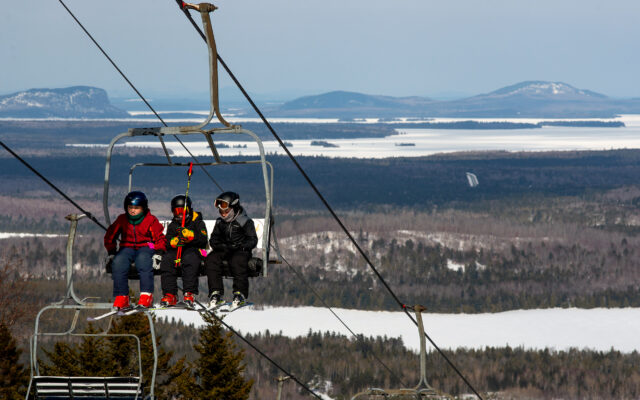
Moosehead ski resort developers revise plans to reduce impact on wildlife
Developers of a proposed year-round ski resort in Piscataquis County have revised their plans to have less impact on wildlife habitats and the environment on Big Moose Mountain.
Of particular concern to the state is habitat for the Northern Spring salamander, the Bicknell’s thrush — a small, brown songbird — and the Roaring Brook mayfly.
The Maine Department of Inland Fisheries and Wildlife recommended the revisions in June. In December, ski resort developers submitted plan changes to the Maine Land Use Planning Commission to deal with the state’s concerns.
Now parties around Piscataquis County and the state will have a chance to weigh in. Although the property sale has not been finalized, this is a significant step in a project that began more than three years ago. If those evaluating the pending application — including the Maine Department of Inland Fisheries and Wildlife, the Bureau of Parks and Lands, Piscataquis County commissioners, Sen. Paul Davis and Rep. Paul Stearns and others — remain supportive, the Land Use Planning Commission would move to draft a decision on the proposal, said Stacie Beyer, acting executive director for the agency.
The Moosehead Lake Ski Resort would replace the Big Squaw Mountain Ski Resort, whose owner, James Confalone of Florida, the state sued in 2016 for failing to maintain the property. The court has not decided whether damages will be assessed, but a hearing on the matter took place Dec. 14-15.
Because the proposed ski resort is located in Big Moose Township, an unorganized territory just north of Greenville, any development requires permitting from the Land Use Planning Commission, Beyer said in late November.
“If they go beyond the phase one development of the core village, they will trip the site location’s development law and need a permit from the [Maine Department of Environmental Protection] at that point,” she said.
Revised site plans for the ski resort — projected to fully open in December 2023 or January 2024 — include relocation of the lower terminal zipline, removal of the Outdoor Center and replacement of overhead utility lines rather than underground burial, according to the planning commission.
The Outdoor Center, a new building that would have served as the departure point for cross-country skiing, skating and snowshoeing, was part of the developers’ original proposal that included a repurposed wastewater lagoon and upgraded skating surface, according to the application.
Matthew Dieterich, the James W. Sewall Co.’s executive vice president, wrote to the commission with updates on Dec. 9, requesting that the permit application be reviewed as quickly as possible.
Along with Perry Williams of Big Lake Development LLC and nonprofit Provident Resources Group of Baton Rouge, Louisiana, Yarmouth-based Treadwell Franklin Infrastructure Capital is one of the ski resort project partners. The project development and finance company bought engineering consulting firm Sewall in 2018.
“Since the issuance of their [wildlife department] review, additional studies have been conducted that will help refine the discussion,” Dieterich said in the letter. “It was our hope that these studies would be completed and could be included in our response. Unfortunately we have yet to receive complete data and need to move the permit process forward in order to purchase the property from the current landowner.”
The wildlife department’s review from this summer focused on phase one of the project, including the replacement of the existing chairlift, surface lifts and a snowmaking system; a base lodge and conference center; a 60-key hotel and restaurant; a zip-lining course; and facilities to support night sky “astro tourism.”
The wildlife department also raised concerns about a proposed 200-slip marina on Moosehead Lake, part of phase two, and its impact on aquatic habitats and fisheries resources.
Dieterich’s letter to the planning commission addressed the department’s recommendations. For example, although final reports aren’t available on Roaring Brook mayfly and northern spring salamanders, neither species was observed in areas around the impound dam associated with the existing snow-making intake. To minimize impacts to the mayflies, lighting at the ski resort will be “Dark Sky compliant” and bug zappers will be avoided.
Bicknell’s thrushes were present at the top of the mountain. It will be a challenge to avoid construction between May 1 and July 1, the letter said, but “the edge surrounding the development and trails in this sensitive habitat will be cleared in a manner that promotes a feathered edge of young fir and spruce growth as recommended.”
Site plan revisions also detail that to minimize erosion and sedimentation within the stream, the developers will comply with the wildlife department’s recommendations to replace culverts and to stabilize snowmaking equipment drain outlets. There also will be no impact within 100 feet of vegetative regions adjacent to wet areas such as streams, the lake or wetlands.
Piscataquis County commissioners originally endorsed the project in February and supported developers seeking up to $135 million in bonds to finance it.
The commissioners remained supportive when they met on Dec. 21, unanimously passing a motion that said they have no concerns about the changes to the proposal. They and other parties have until Jan. 3, 2022, to respond to the planning commission.
When it comes time for the commission to issue a decision, the agency has to consider a comprehensive list of factors and regulatory standards, Beyer said. The commission cannot approve a project without adequate technical and financial provisions, which includes boating, parking and circulation of land, water and air traffic, she said.
“Our responsibility is established in statute to protect the natural character of the Unorganized Territory, but also allow for economic development that’s appropriate,” she said.
BDN writer Judy Harrison contributed to this report.